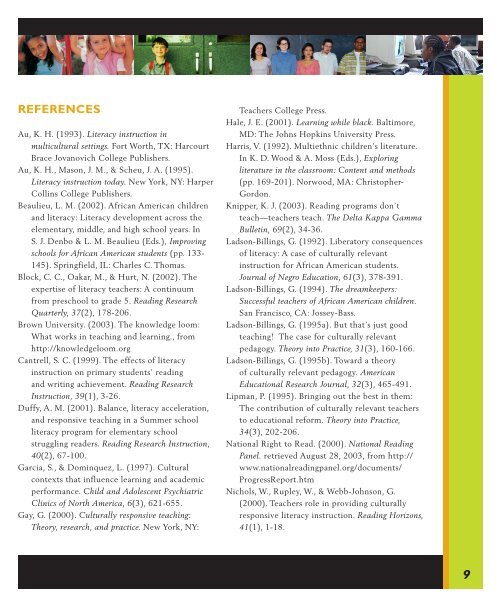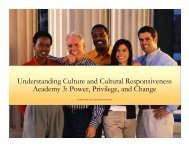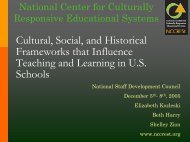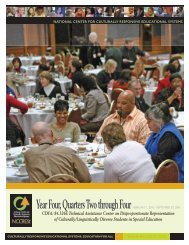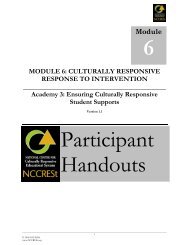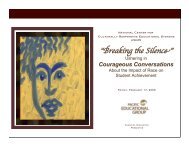CULTURALLY RESPONSIVE LITERACY INSTRUCTION - NCCRESt
CULTURALLY RESPONSIVE LITERACY INSTRUCTION - NCCRESt
CULTURALLY RESPONSIVE LITERACY INSTRUCTION - NCCRESt
You also want an ePaper? Increase the reach of your titles
YUMPU automatically turns print PDFs into web optimized ePapers that Google loves.
ReferencesAu, K. H. (1993). Literacy instruction inmulticultural settings. Fort Worth, TX: HarcourtBrace Jovanovich College Publishers.Au, K. H., Mason, J. M., & Scheu, J. A. (1995).Literacy instruction today. New York, NY: HarperCollins College Publishers.Beaulieu, L. M. (2002). African American childrenand literacy: Literacy development across theelementary, middle, and high school years. InS. J. Denbo & L. M. Beaulieu (Eds.), Improvingschools for African American students (pp. 133-145). Springfield, IL: Charles C. Thomas.Block, C. C., Oakar, M., & Hurt, N. (2002). Theexpertise of literacy teachers: A continuumfrom preschool to grade 5. Reading ResearchQuarterly, 37(2), 178-206.Brown University. (2003). The knowledge loom:What works in teaching and learning., fromhttp://knowledgeloom.orgCantrell, S. C. (1999). The effects of literacyinstruction on primary students’ readingand writing achievement. Reading ResearchInstruction, 39(1), 3-26.Duffy, A. M. (2001). Balance, literacy acceleration,and responsive teaching in a Summer schoolliteracy program for elementary schoolstruggling readers. Reading Research Instruction,40(2), 67-100.Garcia, S., & Dominquez, L. (1997). Culturalcontexts that influence learning and academicperformance. Child and Adolescent PsychiatricClinics of North America, 6(3), 621-655.Gay, G. (2000). Culturally responsive teaching:Theory, research, and practice. New York, NY:Teachers College Press.Hale, J. E. (2001). Learning while black. Baltimore,MD: The Johns Hopkins University Press.Harris, V. (1992). Multiethnic children’s literature.In K. D. Wood & A. Moss (Eds.), Exploringliterature in the classroom: Content and methods(pp. 169-201). Norwood, MA: Christopher-Gordon.Knipper, K. J. (2003). Reading programs don’tteach—teachers teach. The Delta Kappa GammaBulletin, 69(2), 34-36.Ladson-Billings, G. (1992). Liberatory consequencesof literacy: A case of culturally relevantinstruction for African American students.Journal of Negro Education, 61(3), 378-391.Ladson-Billings, G. (1994). The dreamkeepers:Successful teachers of African American children.San Francisco, CA: Jossey-Bass.Ladson-Billings, G. (1995a). But that’s just goodteaching! The case for culturally relevantpedagogy. Theory into Practice, 31(3), 160-166.Ladson-Billings, G. (1995b). Toward a theoryof culturally relevant pedagogy. AmericanEducational Research Journal, 32(3), 465-491.Lipman, P. (1995). Bringing out the best in them:The contribution of culturally relevant teachersto educational reform. Theory into Practice,34(3), 202-206.National Right to Read. (2000). National ReadingPanel. retrieved August 28, 2003, from http://www.nationalreadingpanel.org/documents/ProgressReport.htmNichols, W., Rupley, W., & Webb-Johnson, G.(2000). Teachers role in providing culturallyresponsive literacy instruction. Reading Horizons,41(1), 1-18.9


